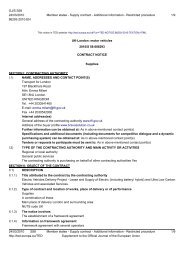Life cycle costing (LCC) as a contribution to sustainable construction ...
Life cycle costing (LCC) as a contribution to sustainable construction ...
Life cycle costing (LCC) as a contribution to sustainable construction ...
You also want an ePaper? Increase the reach of your titles
YUMPU automatically turns print PDFs into web optimized ePapers that Google loves.
Towards a common European methodology for <strong>Life</strong> Cycle Costing (<strong>LCC</strong>) – Guidance Document<br />
13<br />
4 The Common Methodology in public procurement<br />
4.1 Key considerations for public procurers<br />
The Common Methodology is designed <strong>to</strong> accommodate the needs of both public and private<br />
sec<strong>to</strong>r users of <strong>LCC</strong> on <strong>construction</strong> works projects, though the particular orientation of this<br />
guidance document is <strong>to</strong>wards the public procurer.<br />
Clearly, public and private users will have different objectives and considerations when<br />
contemplating investment/expenditure on works projects. In particular, public users may<br />
differ from their private sec<strong>to</strong>r counterparts in the extent of the duration of their interest in<br />
the constructed <strong>as</strong>set, and in the value they place on money, for example. The Common<br />
Methodology considers these <strong>as</strong>pects in detail, and the overall approach recognises that,<br />
whilst private and public users will put different values on these (and other) parameters, the<br />
underlying analysis processes are essentially the same for both of them.<br />
However, the Guidance recognises that public users of the Common Methodology may wish<br />
<strong>to</strong> give special consideration <strong>to</strong> the values <strong>to</strong> be placed on particular parameters – depending<br />
of course on their own national government preferences for investment in the public arena –<br />
including:<br />
Low or zero real discount rates, reflecting the particular nature of public works projects <strong>as</strong><br />
social rather than investment capital (see Step 4.4 of the Methodology)<br />
“Cradle <strong>to</strong> grave” (life <strong>cycle</strong>) or long periods of analysis (see Step 4.2 of the<br />
Methodology)<br />
Low or zero income/revenue flows<br />
Selection of systems and components b<strong>as</strong>ed principally on their longevity/durability and<br />
sustainability performance (with a particular emph<strong>as</strong>is on environmental and societal<br />
impacts) – see Step 3 of the Methodology).<br />
By using the Common Methodology, public procurers can ensure that they have taken<br />
account of all costs <strong>as</strong>sociated with buildings and built infr<strong>as</strong>tructure over the life <strong>cycle</strong> of<br />
these <strong>as</strong>sets. In this way they can and encourage the <strong>construction</strong> supply-side <strong>to</strong> be<br />
innovative in its approach and, in general, help improve the quality and sustainability of the<br />
public built environment.<br />
4.2 Economic and regula<strong>to</strong>ry context<br />
4.2.1 Overview<br />
Public procurement in the European Union (EU) is very significant, accounting for around<br />
16% of the region’s GDP, equivalent <strong>to</strong> some €1,500 billion in 2005. In the <strong>construction</strong><br />
sphere, procurement of works by public bodies accounts for some 20% of all public<br />
procurement.<br />
The EU Procurement Directives set the legal framework for public procurement. Their<br />
purpose is <strong>to</strong> open up the public procurement market and <strong>to</strong> help ensure the free movement<br />
of goods and services within the EU. These Directives apply when Public Authorities and<br />
Utilities wish <strong>to</strong> procure building or civil engineering works, goods and/or services.<br />
Davis Langdon Management Consulting May 2007







